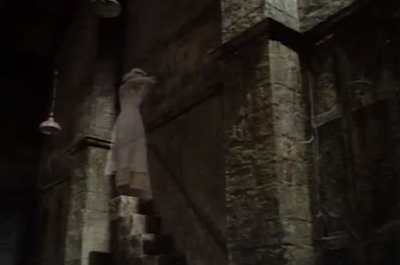Format: Internet video on The Nook.

We live in a golden age of television to be sure. Shows now have actual budgets, for instance. In the past, a television show had enough for the actors and the sets, which meant that shows needing a larger budget—science fiction and fantasy in particular—made do with crap effects. With The Stone Tape, made for the BBC in 1972, we’re very much dealing with that problem. The Stone Tape because of when it was made and how it was made has the same sort of effects as old Doctor Who episodes. That comes into play at the end of this. Fortunately, we have a strong enough base here that it doesn’t matter much.
An electronics company called Ryan Electrics has taken possession of an ancient Victorian mansion called Taskerlands with the intent of setting up a new research facility. The goal of the team, under the direction of the brash Peter Brock (Michael Bryant) is to develop a new recording device, hopefully beating the Japanese to the technology. Brock is hopeful, but is distressed to learn that the men called in to refurbish the old house have refused to work in a back room. While it’s not stated overtly, it’s hinted that the room may be haunted. Since this is a horror movie, it’s a safe bet that that’s the case.
The plan is for the room to be used as storage, but a quick look around from the man who runs the building (Iain Cuthbertson) is that while parts of the room, including a stone staircase, are Victorian, the actual foundations of the building may date back to Saxon times. All of this conjecture is cut short when the team’s computer programmer Jill Greeley (Jane Asher) sees the spirit of a Victorian woman run up the stairs, scream, and disappear. While she seems to be the only one who sees it (another researcher sees it later), almost everyone can hear the screams.
Tests follow. The screams don’t seem to be picked up on any traditional recording devices. Nothing that the team does seems to be able to elicit the screams specifically. The working theory becomes that the ancient stones themselves are some sort of recording medium, and that people are more or less sensitive to that medium and pick up what was recorded within their heads. But as the team investigates further, nothing seems to work to get the “playback” to work, and the setbacks cause a team working on a new washing machine to be given space in the facility as well. Worse, all of the tests seem to have erased the “recording” of the Victorian woman, revealing something much more ancient and darker recorded on the stones previously.
The Stone Tape works mainly through the atmosphere it creates. It also works because the characters are completely believable. We’ve got a situation where a few people can see what looks like a spirit and almost everyone can hear it, but the team doesn’t want to call it a ghost. They instead start exploring the idea of the stones themselves because they’re looking to find a way to exploit it. That might seem a little crazy at first, but I think it’s entirely in keeping with people in this position. We have something new—how do we monetize it? Peter Brock has almost convinced himself that he’s not in the presence of the supernatural because in a real way, his job depends on it.
Where The Stone Tape fails is in those special effects at the end. They’re cheap and they look cheap and unfortunately there’s no way they can’t be cheap because of the budget, and it does really seem to damage the final act of the story. It’s a shame, but it fortunately doesn’t ruin the film. It just makes it feel cheaper than the first 75 minutes have felt.
What works here and works well is that we are given a really interesting and compelling story acted very well. Director Peter Sasdy relies far too much on moving his camera up above the room and looking down on the people every time the screaming starts, but for the first few times this happens, it really works well to increase the tension and create a sense of impending dread.
Sadly, The Stone Tape is limited by the scope of the production. The story, though, is fantastic, and it’s good enough that someone should rework it a bit and come in with a real budget to handle the end in a way that works. And by the way, it’s worth saying that “end” here doesn’t include the actual concluding moments, which pay off for the entire film. I enjoyed the hell out of this and I’m happy to have seen it. It’s playing on YouTube right now, and if you like a creepy little story, you could do a hell of a lot worse.
Why to watch The Stone Tape: A good slow build and a great conclusion.
Why not to watch: The effects are pretty laughable.
